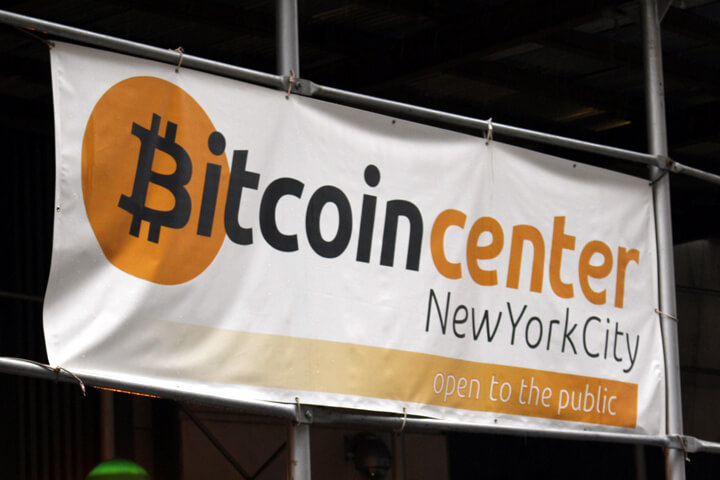Gastbeitrag von Chiara Sommer
Blockchain: Bitcoin challenging the monetary system

While I personally don’t use drugs, my interesting journey with Bitcoin started with pot: I was in New York in 2012 (Bitcoin price was around 10$) where friends of mine bought pot with bitcoins. They used bitcoin because of its alleged anonymity and untraceability. Since I never bought pot, I unfortunately didn’t buy bitcoin at this price. Back then though I still thought that this is an incredible idea and realized already some of its advantages. I actually told my father who very early on started working with the internet that this is as well an innovation with its first use cases in pornography and drugs and might also end up as something way bigger (not clear at the time though where this could end up and what the real implications were). Back in Germany I tried to buy some bitcoins but gave up pretty quickly since I found it to be too complicated. After that – to be honest – I forgot about bitcoin.
Bitwala: Bitcoin for mainstream
In 2015 (bitcoin price was around $350), working as an Investment Manager for High-Tech Gründerfonds, I met the founders of Bitwala Jörg von Minckwitz and Jan Goslicki. Both bitcoin enthusiasts and early backers who raised my interest in Bitcoin again. They built a company to easily buy and spend bitcoin by doing SEPA payments and providing the customer with a debit card to withdraw cash and pay bills in many fiat currencies with bitcoin. By using the Bitwala debit card customers can pay any merchant with bitcoin that accepts debit cards (offline and online). It was one of the few applications that allowed mainstream users to interact with bitcoin and allowed them to spend money the way they were used to. It connected the blockchain to our established monetary system. Soon Bitwala will also offer fiat-to-fiat payments based on the blockchain without the user knowing that the payment is being settled in bitcoin. A transfer will for example go from Euro to Bitcoin, from Bitcoin to Yen in real-time at marginal cost. (Disclaimer: HTGF is a minority shareholder in Bitwala)
The rationale of the investment was that the biggest obstacle for me and hence probably also for many others to join the cryptocurrency world was Bitcoin’s inferior usability. Besides that the offer of a cryptocurrency seems to be very attractive especially in a globalized tech-world due to the reasoning that is about to follow.
The definition of money
Before we explore Bitcoin further, I would like to remind you of the definition of money and how the established monetary system works: “money is a liquid asset used in the settlement of debts that functions based on the general acceptance of its associated value within an economy. The value of money is not necessarily derived from the materials used to produce the note or coin and, instead, derives based on the amount shown on its face partnered with the public’s willingness to support the value as displayed.” Money is always what people are accepting for a transaction. There has been a time where shells, food, animals or metals have been used. While coins were used for a long time, paper printing technology enabled the production of banknotes. People need to believe in a currency in order for its value to exist. In order to validate the value of money, the state has the juridical power to produce money and establish certain standards. The people have trusted established and powerful states to keep up the value of a currency.
Manipulating the value of money
Central banks possesses a monopoly on increasing the monetary base in the state. And unfortunately there has then always been the temptation for a state, its rulers and organs to manipulate the value of money when a commercial, economic or financial crises arose. Thus it is an old phenomenon that the state issued certain copper, silver or gold coins with a certain nominal value, but then regularly changed its valuable metal content by replacing it with a less valuable material. This so-called coin deterioration goes back to the ancient times on to the Middle Ages to modern times. This has then led to regular crisis in trust towards a currency. During those crises it has happened frequently that cities or banks gave out their own banknotes or bonds since certain groups enjoyed more confidence in them than in the currency backed by the state. For example, during the Great Depression in 1929 American cities issued their own banknotes to keep up the economic cycle. It has always been the central question which currency enjoys the most confidence. With the spread and networking of electronic technology, it is logical that money is produced and used electronically. For decades, state institutions, central banks and banks have been managing the monetary and fiscal system with computers.
However, since economic crises continue to occur periodically (although attempts have been made to eliminate or at least dampen them by new procedures and institutions for many years), the old temptation of states, its institutions and politicians to manipulate money still exists. The old system of coin deterioration that was mentioned before has only taken on a new form, and has become easier with electronic systems. Coins don’t need to be monetized and bills don’t need be printed anymore. The push of a button can produce an unlimited amount of money. BUT: People still need to maintain their trust in “money”. Otherwise the whole monetary and economic system will not work anymore. As David Perry put it: “The problem is not a loss of money or credit, it’s a loss of trust.” While it usually takes a long time to build trust, it can collapse in a few seconds. Losing confidence in the system has always had severe consequences for the economic cycle. Therefore, central banks, governments, banks “manage” this confidence.
Impact of artificially producing money
The last major challenge was the sudden instability of the financial system in 2007/2008 with a very strong collapse of confidence by all market participants. Big banks were suddenly no longer willing to give other banks loans (not even for hours). Debt relationships between large participants of the financial system collapsed within a few hours so that huge claims became worthless. For example, the world’s largest insurer AIG was close to bankruptcy. Since AIG insured a majority of all airplanes, the air traffic would have come to a standstill and consequently this would have disrupted a lot of economic sectors. In order to restore confidence of major market participants, governments and central banks have immediately generated huge amounts of money by pressing the key of a button. AIG has received $86 billion and the state took over the majority of its shares. This was soon replicated by other states in a very short time to save other banks and insurance companies worldwide. Governments and central banks have ‘replaced’ the missing funds with money that has been ‘produced’ virtually.
Obviously the question immediately arose: what impact will this artificially produced money have? A majority of people thought that this would result in a massive monetary devaluation. However, this fear has not been confirmed by the year 2017. Confidence in the state’s governing system of money was quickly restored, and it was even strengthened by the decisive actions of central banks. They are now regarded as omnipotent. Now, ten years after the crises, central banks continue to print money massively so that the confidence has been restored on the surface but the system is not stable. What cannot be ignored is that there has been massive inflation in asset classes such as equities, real estate and art (although the general cost of living fortunately has not dramatically increased). Even Deutsche Bank CEO John Cryan says that there are many signs for a bubble now in areas of the financial market where they would have never been expected and asks for an end of cheap money.
Directly after the crises, a minority of people was left with doubt about the sustainability of the monetary system. For example, there were attempts to replace money bills with precious metals (e.g. gold, silver), a thousand-year-old form of money. From 2007 to 2011, precious metals have also enjoyed a huge increase in value. However, with the return of confidence in the state-controlled monetary system, metals lost their ground again.
The rise of crypto-currencies
Around the same time, the crypto currency Bitcoin has been invented due to the same distrust in the monetary system. The peer-to-peer system allows transactions to take place between users directly, without an intermediary, who usually would take a heavy toll on each transaction. Transactions are being verified by network nodes and recorded in a public distributed ledger called a blockchain. This means that Bitcoin is not controlled by any government, it is a decentralized digital currency without a central repository or administrator. A system that is based on mathematics to ensure the integrity of databases, seemed to offer a new way to produce money that could not be manipulated by the state or central banks. An introduction phase and wider usage of the cryptocurrency has increasingly strengthened the confidence of market players in the system. If people believe in a currency like Bitcoin it automatically has value as outlined above. If the belief fades the asset loses its value. Most people in the 21st century believe in technology and mathematics.
In addition, Bitcoins are not being printed but produced through a minin process which has its costs. Hence, in contrast to money bitcoin has a value because it costs something to produce it (currently mining a bitcoin costs around $1.000) and it cannot be produced artificially by someone pressing a button since more computer power is needed. As explored above one of the main criticisms of our current monetary system is that central banks keep on producing money to service debt. With bitcoin that would not be possible since the number of bitcoins is limited and each new bitcoin has a cost to be produced. Three of the main characteristics of bitcoin are 1) it is hard to earn, 2) it is limited insupply and 3) it is easy to verify.
Governments’ attention on Bitcoin
The exponential growth in 2017 in this mathematically encrypted money and its independent possibility to create money outside the sphere of the influence of governments and central banks is now evoking their attention. There might be thus a possible problem in the management of trust in national currencies. In the next periodic financial and / or economic crisis, market participants might be able to move into crypto currencies and the management of trust in money issued by the state could be made more difficult. At the same time, some market participants realized that more crypto-currencies can be used to create new money (and also power new services) through Initial Coin Offerings (ICOs) – not much different from money, which in the past has been issued by individual cities or banks (“alternative currencies”). Now this is being done in a new, electronic way.
The intrinsic characteristic of Bitcoin allows it to be a truly global currency. It is logical that controlling states like China (and also the US especially since 9/11) are either forbidding, weakening or regulating Bitcoin. It is a threat to any centralized banking system that it is losing control of the monetary system as well as for Banks since they are losing their margins for operating as middlemen. With bitcoin neither of them is needed nor would they have centralized power. This is why J.P. Morgan CEO Jamie Dimon is saying “Bitcoin is a fraud” and why the SEC is working on regulating Bitcoin. The number one reason why Bitcoin does not have a higher value yet (besides the usability) is because the established system is against it. Every upcoming crisis and the resilience of bitcoin during those times will show that the people will trust crypto more than the government and the established system.
Looking at the market capitalizations of currencies, stock markets and tech companies, Bitcoin plays a small role. But it gets a lot of attention due to its disrupting implications on the monetary system.
Hence the debate is much more fundamental and philosophical than what price Bitcoin can reach (almost $5.000 in September 2017). The question is whether people will be allowed to control the monetary system democratically or whether the power will stick with centralized organizations like states and banks. Libertarian people should actually have a clear answer to that. Or is a debt paid a kept friend?
PS: For learning more about to the history of Bitcoin, getting to know the movement and the regulatory position, I can highly recommend the Netflix documentary ‘Banking on Bitcoin’
Zur Autorin
Chiara Sommer ist Senior Investment Manager beim High-Tech Gründerfonds (HTGF). Die Wirtschaftswissenschaftlerin und Gründerin eines Online-Beratungs-Startups hat umfassende Erfahrungen im Bereich Marketing, Produktentwicklung, Business Development / Sales, Fundraising und Corporate Finance. Die primären Investitionsfelder sind Marktplätze, Apps, SaaS und Fintech.
Kennt Ihr schon unseren #StartupTicker? Der #StartupTicker berichtet tagtäglich blitzschnell über die deutsche Start-up-Szene. Schneller geht nicht!
Startup-Jobs: Auf der Suche nach einer neuen Herausforderung? In der unserer Jobbörse findet Ihr Stellenanzeigen von Startups und Unternehmen.











